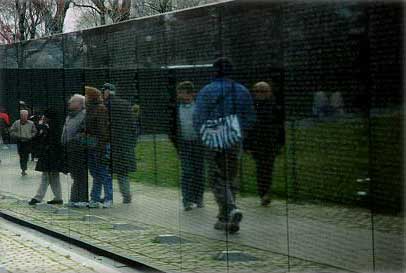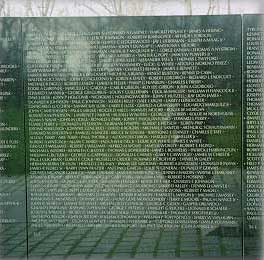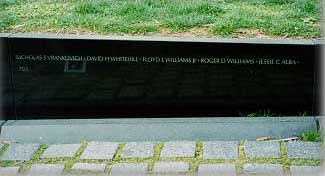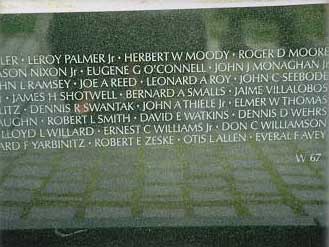| The
Vietnam Veterans War Memorial

Statement
by Maya Ying Lin, March, 1981
(presented as part of her competition submission)
"Walking
through this park-like area, the memorial appears as
rift in the earth, a long, polished, black stone wall,
emerging from and receding into the earth. Approaching
the memorial, the ground slopes gently downward and
the low walls emerging on either side, growing out of
the earth, extend and converge at a point below and
ahead. Walking into this grassy site contained by the
walls of the memorial we can barely make out the carved
names upon the memorial's walls. These names, seemingly
infinite in number, convey the sense of overwhelming
numbers, while unifying these individuals into a whole.
Read
her entire statement
The
Vietnam Veterans Memorial Fund, Inc., a nonprofit charitable
organization formed to establish the memorial, was the idea
of Jan Scruggs, a former infantry corporal during the war.
Read
Scruggs' forward to the book, Reflections on the Wall.
There
were several criteria that established the design of the
memorial:
(1)
The design should be reflective and contemplative in nature.
(2)
The design should harmonize with its natural surroundings,
especially the neighboring memorials.
(3)
The design should contain the names of all who died or
remain missing.
(4)
The design should make no political statements about the
war.
By
separating the issue of those who served in Vietnam from
that of U.S. policy in the war, the group hoped to begin
a process of national reconciliation.
On
July 1, 1980, Congress authorized a site in Constitution
Gardens for the Vietnam Veterans Memorial. A national competition
was held that fall to select the design for the Memorial.
1,421 entries were submitted and judged anonymously by a
jury of eight internationally recognized artists and designers.
The
wining design was the creation of Maya Ying Lin of Athens,
Ohio, who at that time was a 21-year-old undergraduate student
at Yale university. Her concept was for two long walls to
meet at a center creating a chevron shape. Maya Ying Linn
conceived her design as creating a park within a park --
a quiet protected place unto itself, yet harmonious with
the site. To achieve this effect she chose polished black
granite for the walls. Its mirror like surface reflects
the surrounding trees, lawns, monuments, and the people
looking for names.
Maya
Lin has since gone on to design many marvelous works of
art, which like the Wall are abstract and contemplative
in nature, including the Civil Rights Memorial build in
Montgomery, AL and the Wave Field at the University of Michigan.
An Oscar-winning documentary entitled "Maya Lin: A
Strong Clear Vision" was made about her in 1995.
Ground
was broken for the Memorial on March 26, 1982, and the Memorial
was dedicated November 13, 1982. The $7 million cost for
the memorial was raised entirely through contributions.
|
| |
| 
One
wall points toward the Washington Monument and the other
toward the Lincoln Memorial, thus linking the Vietnam Veterans
Memorial Memorial to the historical context of the National
Mall.
An
aerial shot of the memorial |
| |
|  From the nearby street, the memorial is
invisible. It is not until you are almost on top of the
Wall, that you begin to experience its power. From the nearby street, the memorial is
invisible. It is not until you are almost on top of the
Wall, that you begin to experience its power.
There
is a walkway along the sides of the Wall; each side is almost
250 feet long. At the center, or vertex, the height of the
Wall is slightly over 10 feet. |
| |
 The
list of names begins at the vertex of the walls below the
date of the first casualty, 1959, and continues to the end
of the east wall.
The
list resumes at the tip of the west wall, ending at the
vertex, above the date of the last death, 1975.
With
the meeting of the beginning and ending, a major epoch in
American history is signified. |
| |
| 
The
walls are made of polished black granite from Bangalore,
India. It was cut and fabricated at Barre, Vermont. The
names were grit-blasted in Memphis, Tennessee. Each individual
name is slightly over half an inch high.
Chiseled
on the wall are the names of the 58,196 men and women who
either died or are still listed as missing in Southeast
Asia between 1959 and 1975. Each name is preceded on the
west wall or followed on the east wall by one of two symbols:
a diamond or a cross. The diamond denotes that the individual's
death was confirmed. There are approximately 1,300 persons
whose names are designated by a cross; these people are
either missing or prisoners at the end of the war and remain
unaccounted for.
The
individuals are listed chronologically in the order that
they were lost. |
| |
| Details |
|  Each of the two walls of the Memorial is composed of 70
separate inscribed granite panels. The largest panels have
137 lines of names; the shortest have one line. Each of the two walls of the Memorial is composed of 70
separate inscribed granite panels. The largest panels have
137 lines of names; the shortest have one line.
On
each wall the panels are numbered from "1" to
"70," with panel No. 1 at the vertex and panel
No. 70 at the far end. Panel numbers are inscribed at the
bases of the panels. On every second panel, every tenth
line is denoted by a marker in the margin to facilitate
counting the lines. |
| |
|

The
names of the first casualties (July, 1959) appear on the
first line of panel No. 1 on the east wall below the date
"1959." The chronological listing of the names
by date of casualty (DOC) proceeds line by line down each
panel and then to the top line of the panel to the right,
as though the panels were pages in a book.
Quoting
from the statement presented with Maya Lin's submission:
"The
Memorial is composed not as an unchanging monument, but
as a moving composition to be understood as we move into
and out of it. The passage itself is gradual; the descent
to the origin slow, but it is at the origin that the Memorial
is to be fully understood. At the intersection of these
walls, on the right side, is carved the date of the first
death. It is followed by the names of those who died in
the war, in chronological order. These names continue
on this wall appearing to recede into the earth at the
wall's end. The names resume on the left wall as the wall
emerges from the earth, continuing back to the origin
where the date of the last death is carved."
|
| |
|

The
sequence of names proceeds from panel No. 70 on the east
wall to panel No. 70 on the west wall. The listing continues
on each panel to the right, until the names of the last
casualties (in May, 1975) form the last lines of panel No.
1 on the west wall, above the date "1975."
|
| |
| 
This
is the last panel, 70, in the east wall, and has only one
line of names. |
| |
| 
This
panel is number 67 on the west wall. |
| |
| 
A
book is provided in a glass case to find names. It gives
the names in alphabetical order and includes the position
on the Memorial. |
| |
| For
more information about the Memorial:
Reflections,
Memories, and Images of Vietnam Past
http://grunt.space.swri.edu/thepast.htm
"Remembrance"
is a collection of "Galleries" containing imagery,
stories, poems, songs, maps, and narratives from or about
the Vietnam War era. This section also contains a "Glossary"
of terms and slang used in this era and found in the writings
throughout this Site.
Official
Website of the Vietnam Veterans Memorial Fund
http://www.vvmf.org/index.html
Searchable
Database for the Names on the Wall
http://thewall-usa.com/
|
|
